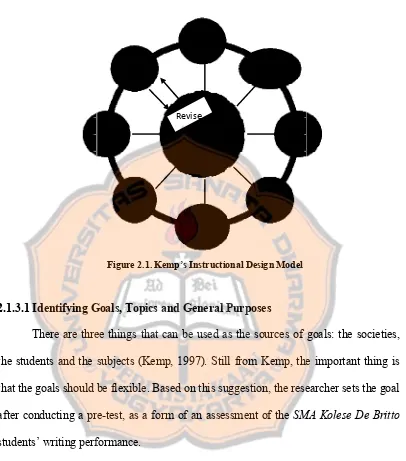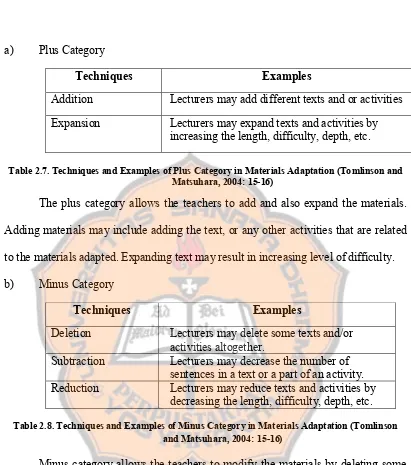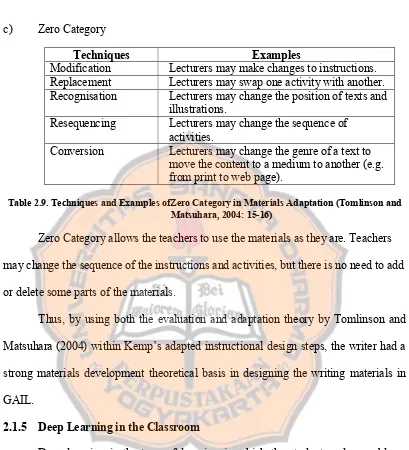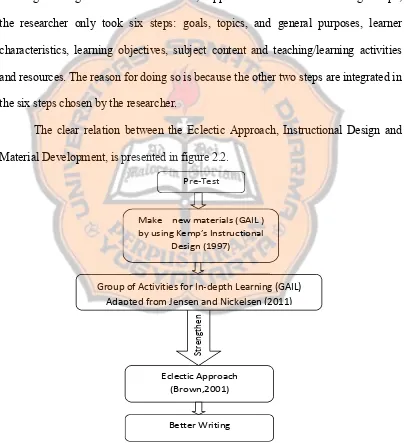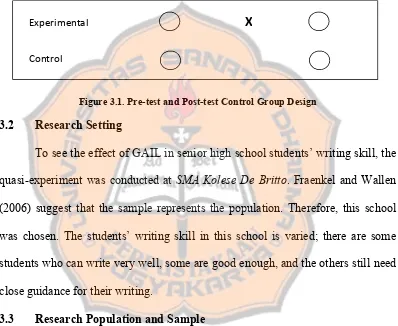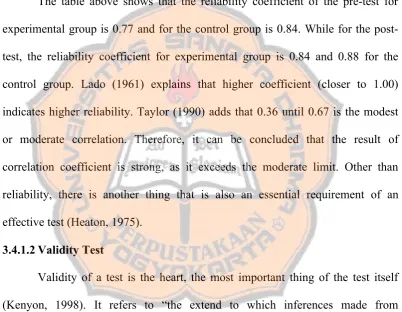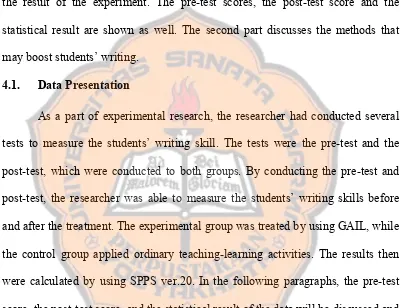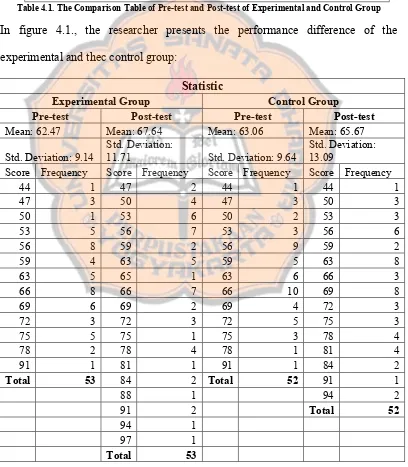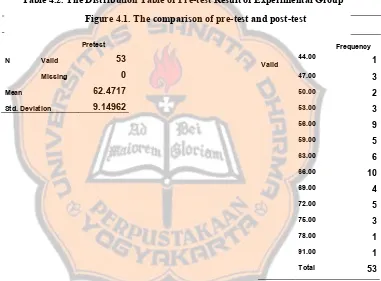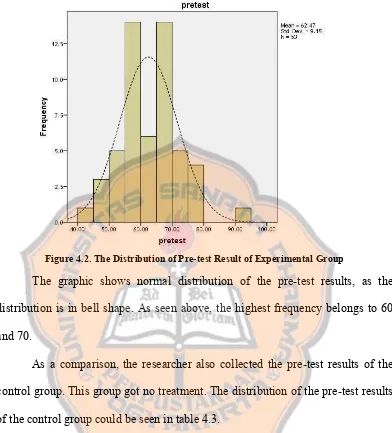Sanata Dharma University.
Writing requires a harder effort from the students compared to the other skills: listening,
reading, and speaking. Especially in Indonesia, students’ writing skill is still insufficient. They
tend to produce a lot of errors and had a lot of difficulties. Some researchers found that the error that frequently appeared in writing was grammatical error, while the most challenging part was developing the ideas in their writing.
Therefore, the researcher designed a set of activities named Group of Activities for In-depth Learning (GAIL) to help students produce better writing. GAIL works well with Eclectic Approach, the combination of Process-based writing and Genre-based writing, since it was made to reinforce every writing process.
The aim of this study was to prove whether GAIL improves SMA students writing skill. The population of this study was the students of SMA Kolese De Britto. For the study, only eleventh grade students of science class were observed as the sample.The main problem
formulation of this study was: does GAIL improve SMA students’ writing skill?
To answer the research questions, the researcher applied the quasi-experimental method. There were two groups in this study: experimental and control groups. Pre-test was conducted before both groups got the treatment. Post-test was conducted after the experimental group got the treatment. The mean score of the experimental group (M=5.1) was slightly higher than the control group (M=2.6). Then result of t-test to compare the performance of both groups showed that the group that used GAIL did not differ significantly (M=5.1,SD=12.4) from the control group that used ordinary teaching-learning activities (M=2.6,SD=14.9), t(103) = 0.95, p > 0.05.
Based on the results of the t-test, it can be concluded that the researcher had enough evidence to reject the null hypothesis: GAIL improves SMA students’ writing skill. In addition, the experimental group performed better in the writing organization than the control group. However, the researcher did not have enough evidence to claim that GAIL significantly better than other teaching methods.
Sanata Dharma University.
Menulis membutuhkan usaha yang lebih keras dari siswa dibandingkan kemampuan yang lain: mendengarkan, membaca, dan menulis. Khususnya di Indonesia, kemampuan menulis siswa masih belum mencukupi. Mereka cenderung melakukan banyak kesalahan dan menemui banyak kesulitan. Beberapa peneliti menemukan bahwa kesalahan yang umumnya dilakukan adalah kesalahan tata bahasa, sedangkan mengembangkan ide tulisan adalah hal yang dirasa paling menyulitkan.
Oleh karena itu, peneliti membuat sebuah kumpulan kegiatan bernama Group of Activities for In-depth Learning (GAIL) untuk membantu siswa dalam membuat tulisan yang baik. GAIL sangat sesuai bila digunakan bersamaan dengan Eclectic Approach, perpaduan antara Process-based writing dan Genre-based writing, karena GAIL didesain secara khusus untuk memperdalam setiap tahapan dalam menulis.
Tujuan dari penelitian ini adalah membuktikan apakah GAIL meningkatkan kemampuan menulis siswa SMA. Populasi dari penelitian ini adalah para siswa SMA Kolese De Britto. Dalam penelitian ini, hanya siswa kelas sebelas IPA yang diambil sebagai sampel. Rumusan masalah dari penelitian ini adalah: apakah GAIL meningkatkan kemampuan menulis siswa SMA?
Untuk menjawab pertanyaan tersebut, peneliti menggunakan metode eksperimen semu. Pre-test dilaksanakan sebelum kedua grup mendapatkan perlakuan khusus. Post-test dilaksanakan setelah kelompok percobaan mendapatkan perlakuan khusus. Hasil rerata nilai grup percobaan (M=5.1) sedikit lebih tinggi dari grup kontrol (M=2.6). Kemudian, hasil uji t untuk membandingkan nilai kedua grupmenunjukkan bahwa grup yang menggunakan GAIL tidak berbeda secara signifikan (M=5.1,SD=12.4) dari grup kontrol yang menggunakan kegiatan pengajaran biasa (M=2.6,SD=14.9),t(103)=0.95, p>0.05.
Berdasarkan hasil t-test, dapat disimpulkan bahwa peneliti memiliki cukup bukti untuk menolak null hypothesis: GAIL meningkatkan kemampuan menulis siswa SMA. Selain itu, grup percobaan menunjukkan performa yang lebih baik daripada grup kontrol dalam organization. Namun, tes signifikansi menunjukkan bahwa tidak ada bukti yang kuat untuk mengklaim bahwa GAIL lebih baik dari kegiatan pengajaran yang lain.
(GAIL) TO IMPROVE
Presented as Partial Fulfillment of the Requirements to Obtain the
ENGLISH LANGUAGE EDUCATION STUDY PROGRAM DEPARTMENT OF LANGUAGE AND ARTS EDUCATION FACULTY OF
i
TO IMPROVE SMA STUDENTS’ WRITING SKILL
A SARJANA PENDIDIKANTHESIS
Presented as Partial Fulfillment of the Requirements to Obtain the Sarjana Pendidikan Degree
in English Language Education
By
Maria Agnes Evata Agustianie Student Number: 101214158
ENGLISH LANGUAGE EDUCATION STUDY PROGRAM DEPARTMENT OF LANGUAGE AND ARTS EDUCATION FACULTY OF TEACHERSS TRAINING AND EDUCATION
SANATA DHARMA UNIVERSITY YOGYAKARTA
2015
STUDENTS’ WRITING SKILL
Presented as Partial Fulfillment of the Requirements
ENGLISH LANGUAGE EDUCATION STUDY PROGRAM DEPARTMENT OF LANGUAGE AND ARTS EDUCATION
vi
Agustianie, M. A. (2015). The Use of Group of Activities for In-depth Learning (GAIL) to Improve SMA Students' Writing Skill.Yogyakarta: English Education Study Program, Sanata Dharma University.
Writing requires a harder effort from the students compared to the other skills: listening, reading, and speaking. Especially in Indonesia, students’ writing skill is still insufficient. They tend to produce a lot of errors and had a lot of difficulties. Some researchers found that the error that frequently appeared in writing was grammatical error, while the most challenging part was developing the ideas in their writing.
Therefore, the researcher designed a set of activities named Group of Activities for In-depth Learning (GAIL) to help students produce better writing. GAIL works well with Eclectic Approach, the combination of Process-based writing and Genre-based writing, since it was made to reinforce every writing process.
The aim of this study was to prove whether GAIL improves SMA students writing skill. The population of this study was the students of SMA Kolese De Britto. For the study, only eleventh grade students of science class were observed as the sample.The main problem formulation of this study was: does GAIL improve SMA students’ writing skill?
To answer the research questions, the researcher applied the quasi-experimental method. There were two groups in this study: quasi-experimental and control groups. Pre-test was conducted before both groups got the treatment. Post-test was conducted after the experimental group got the treatment. The mean score of the experimental group (M=5.1) was slightly higher than the control group (M=2.6). Then result of t-test to compare the performance of both groups showed that the group that used GAIL did not differ significantly (M=5.1,SD=12.4) from the control group that used ordinary teaching-learning activities (M=2.6,SD=14.9), t(103) = 0.95, p > 0.05.
Based on the results of the t-test, it can be concluded that the researcher had enough evidence to reject the null hypothesis: GAIL improves SMA students’ writing skill. In addition, the experimental group performed better in the writing organization than the control group. However, the researcher did not have enough evidence to claim that GAIL significantly better than other teaching methods.
vii
Agustianie, M. A. (2015). The Use of Group of Activities for In-depth Learning (GAIL) to Improve SMA Students' Writing Skill.Yogyakarta: English Education Study Program, Sanata Dharma University.
Menulis membutuhkan usaha yang lebih keras dari siswa dibandingkan kemampuan yang lain: mendengarkan, membaca, dan menulis. Khususnya di Indonesia, kemampuan menulis siswa masih belum mencukupi. Mereka cenderung melakukan banyak kesalahan dan menemui banyak kesulitan. Beberapa peneliti menemukan bahwa kesalahan yang umumnya dilakukan adalah kesalahan tata bahasa, sedangkan mengembangkan ide tulisan adalah hal yang dirasa paling menyulitkan.
Oleh karena itu, peneliti membuat sebuah kumpulan kegiatan bernama Group of Activities for In-depth Learning (GAIL) untuk membantu siswa dalam membuat tulisan yang baik. GAIL sangat sesuai bila digunakan bersamaan dengan Eclectic Approach, perpaduan antara Process-based writing dan Genre-based writing, karena GAIL didesain secara khusus untuk memperdalam setiap tahapan dalam menulis.
Tujuan dari penelitian ini adalah membuktikan apakah GAIL meningkatkan kemampuan menulis siswa SMA. Populasi dari penelitian ini adalah para siswa SMA Kolese De Britto. Dalam penelitian ini, hanya siswa kelas sebelas IPA yang diambil sebagai sampel. Rumusan masalah dari penelitian ini adalah: apakah GAILmeningkatkan kemampuan menulis siswa SMA?
Untuk menjawab pertanyaan tersebut, peneliti menggunakan metode eksperimen semu. Pre-test dilaksanakan sebelum kedua grup mendapatkan perlakuan khusus. Post-test dilaksanakan setelah kelompok percobaan mendapatkan perlakuan khusus. Hasil rerata nilai grup percobaan (M=5.1) sedikit lebih tinggi dari grup kontrol (M=2.6). Kemudian, hasil uji t untuk membandingkan nilai kedua grupmenunjukkan bahwa grup yang menggunakan GAIL tidak berbeda secara signifikan (M=5.1,SD=12.4) dari grup kontrol yang menggunakan kegiatan pengajaran biasa (M=2.6,SD=14.9),t(103)=0.95, p>0.05.
Berdasarkan hasil t-test, dapat disimpulkan bahwa peneliti memiliki cukup bukti untuk menolak null hypothesis: GAIL meningkatkan kemampuan menulis siswa SMA. Selain itu, grup percobaan menunjukkan performa yang lebih baik daripada grup kontrol dalam organization. Namun, tes signifikansi menunjukkan bahwa tidak ada bukti yang kuat untuk mengklaim bahwa GAIL lebih baik dari kegiatan pengajaran yang lain.
viii
First of all I would like to thank God for giving me strength and courage in
the process of completing my thesis.
I am also thankful to my major sponsor, Drs. Pius Nurwidasa P., M.Ed.,
Ed.D, for his guidance, patience, and encouragement. I would also like to express
my gratitude to all PBI lecturers, who encourage and give me their meaningful
knowledge.
My deep gratitude also goes to Pak A. Denny, S.Pd, and all the teachers in
SMA Kolese De Britto Yogyakarta who helped me to collect my data. Without
them, it was impossible for me to conduct the research and collect the data. I
would like to thank SMA Kolese De Britto students, especially eleven science
graders, for their great cooperation during the research.
I would like to thank my parents, who always support me mentally and
financially. They always give me strength whenever I am down and are willing to
listen to my stories.
My sincerest thanks go to my friends: Endang Ratmawati Parhusip (Sr.
Ursula), Monica Surya Utami, Deliana Ciciliawati, Bayu Pamungkas and all my
PBI friends 2010. During the process of completing my thesis, they encouraged
and also supported me unconditionally. They were my candles when I was in the
dark and feeling cold. I would like to thank Laurensia Prista Karina, who had
helped me to assess the students’ writing. Last but not least, I also thank Bu Mita,
Olin and Ryo, for their willingness to spare their time and proofread my thesis.
ix
TITLE PAGE ... i
APPROVAL PAGES ...ii
STATEMENT OF WORK’S ORIGINALITY ...iv
PERNYATAAN PERSETUJUAN PUBLIKASI...v
ABSTRACT... ...vi
ABSTRAK... ...vii
ACKNOWLEDGEMENTS ...viii
TABLE OF CONTENTS... ...ix
LIST OF TABLES ...xii
LIST OF FIGURES ...xiii
LIST OF APPENDICES ...xiv
CHAPTER I : INTRODUCTION... 1
1.1 Research Background ...1
1.2 Research Problems... 5
1.3 Problem Limitation ...5
1.4 Research Design ...5
1.5 Research Objectives...6
1.6 Research Benefits ...6
1.6.1 For Teachers ... 6
1.6.2 For the Researcher ... 6
x
1.7 Definition of Terms ...7
CHAPTER II: THEORETICAL REVIEW...9
2.1. Theoretical Description ...9
2.1.1 The Eclectic Approach as a Synthesis of Process-based Writing and Genre-based Writing ...10
2.1.2 Group of Activities for In-depth Learning (GAIL) ...12
2.1.3 Instructional Design in GAIL ...13
2.1.3.1 Identifying Goals, Topics and General Purposes ...14
2.1.3.2 Identifying Learners’ Characteristics ...15
2.1.3.3 Illustrating the Learning Objectives ...16
2.1.3.4 Identifying the Subject Content ...17
2.1.3.5 Collating Learning Activities and Resources ...18
2.1.3.6 Evaluating the Materials ...18
2.1.4 Material Development Theory in GAIL ...19
2.1.5 Deep Learning in the Classroom ...22
2.2 Theoretical Framework...24
2.3 Hypothesis ...26
CHAPTER III: METHODOLOGY...27
3.1 Research Method ...27
3.2 Research Setting ...29
3.3 Research Population and Sample...29
3.4 Instrument ...30
3.4.1 Pre-test and Post-test ...32
3.4.1.1 Reliability Test...32
3.4.1.2 Validity Test ...34
3.4.2 The Rubric for Pre-test and Post-test...36
xi
3.5.2 Conducting the Pre-test...38
3.5.3 Conducting the Post-test ...38
3.5.4 The Method of Collecting Data ...39
3.6 Data Analysis...39
3.7 Hypotheses ...39
3.7.1 Operational Hypotheses...40
3.7.2 Statistical Hypotheses...40
CHAPTER IV: RESEARCH FINDINGS AND DISCUSSION...42
4.1 Data Presentation ...42
4.1.1 The Descriptive Statistic of Pre-test result ...44
4.1.2 The Descriptive Statistic of Post-test result...47
4.2 Data Analysis...51
4.3 The Discussion...53
4.3.1 The Factors that Influenced the Result of the Experiment ...53
4.3.2 Analysis of the Aspect of Organization...56
4.3.3 The Other Findings ...57
CHAPTER V: CONCLUSIONS AND RECOMMENDATIONS...58
5.1 Conclusions ...58
5.2 Recommendations...61
REFERENCES...64
xii
2.1. Techniques and Examples of Plus Category in Materials Adaptation...21
2.2. Techniques and Examples of Minus Category in Materials Adaptation...21
2.3. Techniques and Examples of Zero Category in Materials Adaptation ...22
3.1. Table of Coefficient Correlation Calculation Result ...34
4.1. The Comparison Table of Pre-test and Post-test Score of Experimental and Control Group ...43
4.2. The Distribution Table of Pre-test Result of Experimental Group ...44
4.3. The Distribution Table of the Pre-test Result of Control Group...46
4.4.The Distribution Table of Post-test Result of Experimental Group...47
4.5. The Distribution Table of Post-test Result of Control Group ...49
4.6. The T-test Result of Experimental Group...51
4.7. The T-test Result of Pre-test And Post-test of Control Group ...52
4.8. The Result of T-test...52
xiii
Page
2.1. Kemp’s Instructional Design Model ...14
2.2. The Theoretical Framework of the Research ...25
3.1. Pre-test and Post-test Control Group Design ...29
4.1. The Comparison of Pre-test and Post-test...43
4.2. The Distribution of Pre-test Result of Experimental Group ...45
4.3. The Distribution of Pre-test Result of Control Group...46
4.4. The Distribution of Post-test Result of Experimental Group...48
xiv
Page
1. GAIL Syllabus ... 68
2. Task of Pre-test ... 84
3. Task of Post-test ... 85
4. Assessment Rubric for Expository Writing ... 86
5. Score of Pre-test And Post-test by Raters... 87
6.Research Recommendation from Sanata Dharma ... 91
7. Script of Asking Permission to Conduct Research... 92
8. Research Schedule ... 93
9. The Pre-test Score of Experimental Group... 94
10. The Pre-test Score of Control Group ... 95
11.The Post-test Score of Experimental Group ... 96
1
INTRODUCTION
The writer presents in the first chapter the reasons why this study is
conducted. In the following section, the writer presents the research background,
the research questions and the problem limitation. The research objectives and
research benefits are then presented before the writer finally closes the first
chapter with the terminology used here.
1.1 Research Background
There are four skills in learning a language: speaking, listening, reading
and writing. Among these skills, writing is generally the most challenging skill for
the language learners; it is hard work (Tiedt, 1989). It is even more challenging
for students in senior high school; they are trying to write about the topic that is
not related to themselves (Davis & Winek, 1989). In addition, writings could
cause misinterpretation for the readers when the writer fails to communicate his or
her intention (Farooq, Uzair-Ul-Hassan, & Wahid, 2012).
In Indonesia, senior high school students’ writing skill is still inadequate;
they produce a number of errors in their writing (Megaiab, 2014). In his research,
Megaiab (2014) found that the most common error was grammatical mistakes.
Another researcher, Siahaan (2013) also reached a similar conclusion to one
additional point; sometimes the students were also confused with the schematic
structure of the text. In addition to these problems, the students have difficulties in
1989). Thus, to assist the students in improving their writing skill, the teachers
may apply some approaches.
There are several writing approaches that can be applied. Badger and
White (2000) highlighted the difference between two commonly used approaches;
genre-based and process-writing. In a process writing, the students are expected to
realize the importance of mastering each writing aspect. Unfortunately, it
generally disregards the goal and also the reasons for writing the text. On the other
hand, the genre based approach provides the clear purpose of writing. While
applying this approach, the teachers at the same time undervalue the skills needed
in a good writing. Even though both approaches are commonly used, they actually
address only a particular problem in ESL writing (Min, 2009). Another approach
that may be the “ideal approach which is now considered as the most effective and
successful in the teaching of writing” is the Eclectic Approach (Farooq,
Uzair-Ul-Hassan, & Wahid, 2012, p.185). It combines both approaches to teach writing
(Min, 2009). As a result, writing will have a clear purpose, and should be
completed through several prescribed steps.
The plus point of this approach is seen by SMA Kolese De Britto English
teachers. Based on several discussions that took place during the course of this
study, the teacher agreed that he implemented Eclectic Approach in the teaching –
learning process. The result of the combined approaches helped the students to
produce good writing. It can be concluded from the result of their writings; there
English. The language has become an international language spoken by almost all
people in the world, which means it could provide better work opportunities for
the students (Whaley, 2014). He also explains that the international companies
would like to find the employee who is “adaptable and able to learn fast, someone
eloquent who can write well [in English]” (par.7). In order to fulfill this demand,
producing good and systematic ideas according to the standard is important (Laia,
2014). Furthermore, good writers have to be able to control their writings
(Koeswologito, 2014). Based on the facts presented, certainly the education
system must do something to open more opportunities (Whaley, 2014).
From the sources mentioned previously, it could be concluded that in order
to meet the global expectation, the students need to be able to produce systematic
writing which has good ideas. As the opposite of the expectation, in the beginning
of the discussion it had been mentioned that in Indonesia, structuring the writing
composition and developing ideas are the challenges for students. As the solution
to the problems, the teachers need to vary their teaching approaches in any way
that may help the students to achieve the highest score (Petrilli, 2011). Based on
this suggestion, as one of the paths to meet the global demands of proficient
human resources, the Eclectic Approach that is already applied in the school,
especially SMA Kolese De Britto then needs to be strengthened. The researcher
suggests deep learning as the supporting elements of the Eclectic Approach. Deep
learning itself is a type of learning which leads students to solve problems through
prior knowledge to absorb or grab new materials (Weimer, 2012). Hopefully, by
adding it, the writing product produced by students will be better than before.
In order to implement deep learning in the writing class, the teachers have
to make the instructions applicable in the classroom context (Orlich, Harder,
Callahan, Trevisan, & Brown, 2009). Jensen and Nickelsen (2011) have of several
applicable activities. The researcher adapted some of these activities. The
activities itself consist of planning the standard and curriculum, pre-assessing,
building a positive learning culture, priming and activating prior knowledge,
acquiring new knowledge, processing with a purpose and making the choices for
processing. Due to the limitation of the time, the researcher only adapted the
activities. These activities were later on used in the experiment and called Group
of Activities for In-depth Learning (GAIL).
Noticing the learning phenomenon at De Britto, the researcher is interested
to study the application of GAIL to enhance the Eclectic Approach that has
already been used. Besides, the students here could produce better writing than
they did before. Specifically, the participants are only eleven Science graders. The
researcher chooses them by considering their English proficiency. Many of them
also have many interesting ideas. Seeing the potential possessed by the students,
the researcher would like to observe whether GAIL can improve the students’
Based on the research background mentioned previously, there is one
major research question in this research:
1. Does Group of Activities for In-depth Learning (GAIL) improve SMA
students’ writing skill?
However, this research would also like to answer this question:what aspect
improves the most ?
1.3 Problem Limitation
There are several factors that may influence the students’ writing skills,
such as writing motivation and background knowledge. However, this study will
only focus on the use of GAIL in improving the students’ writing skills. Several
other factors such as learning environment, age and experience may still be there,
but they will not be counted in the research.
1.4 Research Design
This study was quasi-experimental research that was conducted in SMA
Kolese De Britto. There were two groups in this research: the control group and
the experimental group (Ary, Jacobs, Sorenson, & Razavieh, 2010). The
researcher used GAIL to teach English in the experimental group. Meanwhile, the
ordinary teaching and learning which was commonly used in this school was
applied in the control group. The complete description of the research method will
be explained in chapter III. However, the analysis method will be summarized
briefly here. The results of the teaching and learning process of the experimental
experimental group and the control group by applying a t-test.
1.5 Research Objectives
The first objective of this study was to observe the different results of the
control group and treatment group. This difference was then calculated, to
measure the significance. The second objective was observing the improvement in
students’ writing skill after being treated using GAIL.
1.6 Research Benefits
1.6.1 For Teachers
This research may bring new alternative activities, such as Six Thinking
Hats, Make Meaning, and Walk in Others’ Shoes to maximize the students’
potential in learning, especially writing. These activities may bring the students
into higher achievement in the learning process.
1.6.2 For the Researcher
This research is expected to provide an emphirical data for the research.
The data is a valuable input to determine the effect of applying GAIL in the
control and experimental groups. Only after the research had been completed, the
result could be obtained.
1.6.3 For the Future Researchers
This research provides several things to explore in the scope of learning
skills. For instance, the researcher has already given a glimpse of deep learning
and how to implement the activities in the class. Other researchers may explore
a lot of new materials or methods, which may solve students’ writing problems.
1.6.4 For Students
The use of GAIL hopefully will maximize the potential of students’
writing. They may also have new or upgraded point of view about writing
activities and processes. In the end, GAIL will bring new ways to guide the
students to achieve their writings’ goals.
1.7 Definition of Terms
In this session, the researcher provides the definition of the terms used in
the research. The complete explanation is provided in chapter II.
1. Deep Learning
The definition of deep learning is solving problems in more than one step
and with multiple levels of analysis or processing so that students may apply the
content/skills in ways that change thinking, influence, or behaviors.
2. Group of Activities for In-depth Learning (GAIL)
GAIL is a set of adapted learning activities from Jensen and Nickelsen’s
(2011) concept to enhance deep learning. The researcher here adapts only the
activities in order to meet the need of the students.
3. Writing
Writing is a form of comunication to deliver thought or to express feeling
through written form (Harmer, 2001). There are two kinds of writing: writing as
meaning involves arranging words, sentences, and paragraphs into a good text.
All the explanations presented above provide sufficient information to get
a glimpse of the research. The complete discussion of the theories that built this
9 CHAPTER II
THEORETICAL REVIEW
In this chapter, the researcher discusses the basic theories of the topic. The discussions are divided into three major sections: the theoretical description, the theoretical framework and the hypothesis. In the theoretical description section, the writer provides the theories related to the topic. Then, to present how the theories answer the research questions, there is the theoretical framework. At the end of this chapter, the writer presents the hypothesis of this research.
2.1 Theoretical Description
2.1.1 Eclectic Approach As A Synthesis of Process-based and Genre-based
Writing
The initial theory of Eclectic Approach comes from Brown (2001). He stated that the teachers could apply the approach that could accomodate the learners’ need. The Eclectic Approach is considered the most efficient and effective approach as it can cover the disadvantages of using one approach only (Min, 2009). This new approach may combine one or more approaches, as long as it accommodates the need of the students (Petrilli, 2011). In addition, the approach can be applied in all language skills (Larsen-Freeman, 2000). Furthermore, it gives other benefits, such as fun, enjoyable and innovative learning (Kumar, 2013).
Another part of the Eclectic Approach is genre-based writing; it holds the idea that writing serves a purpose and the language is used as a media to achieve this purpose (Hyland, 2003). The purpose of the writing may vary: to get things done, to tell a story, to describe something, etcetera. The writer here uses texts as the media to convey certain information, to make relation with his or her readers, and to achieve the purpose of the text itself. By combining these two approaches, the students will set the purpose of their writing and also go through several steps in order to achive the goal.
In the classroom, the Eclectic Approach encourages learner-centered activities (Richards & Rodgers, 2001). Furthermore, Richards and Rodgers also suggest specific roles of the teachers and learners in the class. For the learners, they have a lot of opportunities to respond to the topic of discussion. In addition, they may also get the information from the other students, not only from the teachers. Still from Richards and Rodgers (2001), as the students are expected to be active (Brown, 2001), the teachers then have to be creative in choosing the materials that would be given to the students. The hardest job is combining the strengths from different activities into an activity that will encourage students to learn independently (Jackson, 2011).
2.1.2 Group of Activities for In-depth Learning (GAIL)
GAIL is a set of activities which will strengthen each writing step in the Eclectic Approach. In the process of making this set of activities, the researcher applies Kemp’s (1997) Instructional Design and Tomlinson and Matsuhara’s (2004) Material Development in order to get a strong theoretical basis. The detailed information about these theories is presented in the following section. Presented below is the explanation of GAIL itself.
Each activity in GAIL is chosen based on the aforementioned considerations and aims to ahieve a certain goal. The goal of choosing activities as the main course is active learning (Jackson, 2011); all the teachers need to do is directing and confirming their understanding (Jensen & Nickelsen, 2011). Even if the teachers need to explain, it should only contain enough information so the students can tell when they have solved the problems (Ohlson, 2011). In addition, activities help the students to follow the writing processes based on the steps provided (Petrilli, 2011). Therefore, the researcher should choose the activities which meet the students’ need (Davison & Dowson, 2003).
The assessments for GAIL are conducted in the beginning and also in the end of the study. They are a part of evaluations in order to be able to make improvement. For the syllabus of GAIL, please refer to APPENDIX 1. In the following section, the detailed explanation of the steps of designing GAIL is presented.
2.1.3 Instructional Design in GAIL
2.1.3.1 Identifying Goals, Topics a
There are three the students and the that the goals should be flex after conducting a pre
students’ writing performance. In this study,
Standard”, and the general Standard and the Basic applied at the school during implementation of Curriculum
Identifying Goals, Topics and General Purposes
are three things that can be used as the sources of goals: the subjects (Kemp, 1997). Still from Kemp, the
the goals should be flexible. Based on this suggestion, the researcher sets the goal conducting a pre-test, as a form of an assessment of the SMA
students’ writing performance.
study, the researcher refers the goals in GAIL the general purposes as “Basic Competencies”. the Basic Competence were taken from Curriculum
school during this study. Further explanation in regards implementation of Curriculum 2013 will be laid out in Chapter V.
Revise
Figure 2.1. Kemp’s Instructional Design Model
sources of goals: the societies, he important thing is Based on this suggestion, the researcher sets the goal SMA Kolese De Britto
2.1.3.2 Identifying Learners’ Characteristics
The materials designed by the teachers should help the students to learn on his their own pace (Petrilli, 2011); thus, it is important to consider the academic and social factors of the students (Kemp, 1997). Furthermore, Kemp (1997) explains that the teachers should also think about the learning conditions and cognitive styles mappings. GAIL was applied in SMA Kolese De Britto with homogenous academic and social factors. The research itself took place in the same place, so it can be concluded that the students had the equal learning environment. These students were the eleventh grader science students of SMA Kolese De Britto. At the time the research was conducted, they were learning about exposition text.
The activities in GAIL encourage the students to use their analysis in the writing text. As Kemp (1997) suggests, the teachers also need to consider four cognitive styles mapping. Set one describes the students who tend to seek from theoretical symbols to get the meaning of something new. Set two mentions about the ability to give meaning from their own experiences. Set three defines the students who like to analyze and give reasoning towards something unfamiliar. The last set, set four, is those who can explain something based on their memories. When the researcher conducted the internship program in SMA Kolese De Britto, she found that the students belonged to set three.
Each learning activity should help the students in one or another way (Petrilli, 2011). Therefore, the researcher should also set clear learning objectives (Kemp, 1997).
2.1.3.3 Illustrating the Learning Objectives
In Kemp’s Instructional Design, the learning objectives become very important because learning itself should be the product or outcome of an instruction. There are three groups of learning objectives suggested by Kemp (1997): cognitive, psychomotor, and affective categories. In the process of making GAIL, the researcher considers two categories only: the cognitive and affective. In general, the teaching-learning activities in the Senior High School level focus more on the cognitive category rather than the affective.
domain; knowledge, comprehension, application, analysis, synthesis and evaluation. As for the affective domain, it becomes one of the priorities because SMA Kolese De Brittoembraces the ideas of working in pairs and groups with the aim to support each other during the learning process. The significance of each of these domains will relate closely to the subject content explained below.
2.1.3.4 Identifying the Subject Content
Kemp (1997) mentioned three things to consider in determining the subject content: selection and organizing of the specific knowledge (facts and information), skills (step-by-step procedures, conditions, and requirements) and attitudinal factors of any topic. The first subject content (selection and organizing of the specific knowledge) deals with the writing activities. The researcher here applies Tomlinson and Matsuhara’s material development theory (2004). To choose the material in GAIL, the researcher considered the result of the pre-test. At the same time, the teachers’ expectation and the students’ writing skills are also included in the subject content.
2.1.3.5 Collating Learning Activities and Resources
After listing the content, the teachers should find the most efficient and effective activity and resource along with the best way to implement them (Kemp, 1997). Furthermore, Kemp also suggests that the teachers choose various materials, each of them works best only in specific part. Referring to the recommendation, the researcher adapted some activities from Jensen and Nickelsen (2001). These activities are especially designed by the writers to enhance deep learning.
In adapting the materials for GAIL, the researcher also implemented Tomlison and Matsuhara’s (2004) Material Development Theory. The teachers who adapt materials from any resources sometimes make some changes in order to make them work in the class (Jackson, 2011). Tomlinson and Matsuhara (2004) mention three categories that are commonly used: plus, minus and zero. In this research, the researcher applied minus category for the activities in GAIL, since there are some modifications in the content of the adapted materials.
These adapted materials which are designed by the researcher may have some flaws. Therefore, to make better materials, an evaluation process is needed.
2.1.3.6 Evaluating the Materials
written in the objectives. At the end of the meeting, the teachers need to assess the students in order to know whether they have achieved the goal.
In this research, the evaluation was conducted two times; before (pre-test) and after (post-test) GAIL (the treatment) was applied. The pre-test was done to measure the students’ writing skill before the treatment. After the treatment was given, the post -test was conducted. In order to maintain the equal aspects of the evaluation (Kothari, 2004), both tests were assessed by using adapted rubric from Wagner (2002).
As mentioned previously, the activites taken for GAIL were chosen by considering material development theory by Tomlinson and Matsuhara (2004). Presented below is the complete explanation of the theory.
2.1.4 Material Development Theory in GAIL
In designing GAIL, the researcher applied minus category. Applying this category meant the researcher made some modifications in the content of the adapted materials (Tomlinson & Matsuhara, 2004). The further reason for choosing minus category was because the researcher decreased the level of difficulties of the materials and omitted the part of sentences in the materials; these actions belonged to minus category in Tomlinson and Matsuhara’s theory. In addition, these steps were done in order to develop some materials that will meet students’ need (Jackson, 2011).
Matsuhara’s (2004) materials development theory into the theoretical framework. The writer intended to utilize this theory to complement Kemp’s (1997) adapted instructional design steps. The materials evaluation and revision of Kemp’s (1997) steps were the focus of Tomlinson and Matsuhara’s (2004) adapted theory. The writer employed two out of five steps of materials adaptation from the mentioned authors, which were: 1) the evaluation, and 2) the adaptation theory. These steps were used as guidances to strengthen Eclectic Approach and to adapt the relevant ones from Deep Learning Cycles as part of Kemp’s revision processes.
Tomlinson and Matsuhara’s (2004) materials evaluation measurements and adaptation techniques were employed and linked to the first and last steps of Kemp’s adapted instructional design. The materials evaluation measurements covered seven inquiry points which were: 1) the appeal or attractiveness of the materials, 2) the validity or whether materials teach worth teaching, 3) the ability of materials to interest the learners (and the lecturers), 4) the ability of the materials to motivate the learners or to stimulate the learners so they want to give time and energy to the materials, 5) the potential learning values, 6) the preparation, delivery and assessment assistance given to the lecturers, and 7) adaptation flexibility of materials by lecturers to suit a particular context .
a) Plus Category
Techniques Examples
Addition Lecturers may add different texts and or activities Expansion Lecturers may expand texts and activities by
increasing the length, difficulty, depth, etc.
Table 2.7. Techniques and Examples of Plus Category in Materials Adaptation (Tomlinson and Matsuhara, 2004: 15-16)
The plus category allows the teachers to add and also expand the materials. Adding materials may include adding the text, or any other activities that are related to the materials adapted. Expanding text may result in increasing level of difficulty. b) Minus Category
Techniques Examples
Deletion Lecturers may delete some texts and/or activities altogether.
Subtraction Lecturers may decrease the number of sentences in a text or a part of an activity. Reduction Lecturers may reduce texts and activities by
decreasing the length, difficulty, depth, etc.
Table 2.8. Techniques and Examples of Minus Category in Materials Adaptation (Tomlinson and Matsuhara, 2004: 15-16)
c) Zero Category
Techniques Examples
Modification Lecturers may make changes to instructions. Replacement Lecturers may swap one activity with another. Recognisation Lecturers may change the position of texts and
illustrations.
Resequencing Lecturers may change the sequence of activities.
Conversion Lecturers may change the genre of a text to move the content to a medium to another (e.g. from print to web page).
Table 2.9. Techniques and Examples ofZero Category in Materials Adaptation (Tomlinson and Matsuhara, 2004: 15-16)
Zero Category allows the teachers to use the materials as they are. Teachers may change the sequence of the instructions and activities, but there is no need to add or delete some parts of the materials.
Thus, by using both the evaluation and adaptation theory by Tomlinson and Matsuhara (2004) within Kemp’s adapted instructional design steps, the writer had a strong materials development theoretical basis in designing the writing materials in GAIL.
2.1.5 Deep Learning in the Classroom
“In the deep approach, the intention to extract meaning produces active learning processes that involve relating ideas and looking for patterns and principles on the one hand (a holist strategy - Pask, 1976, 1988), and using evidence and examining the logic of the argument on the other (serialist).”(p.3) The learning type also involves monitoring the development of one’s own understanding (Entwistle, McCune & Walker, 2000). On the other hand, the surface learning is just coping with the task and seeing the course as unrelated bits of information which leads to much more restricted learning processes, in particular to routine memorization (Weimer, 2012).
This description indicates that complex understanding will help the students to solve complex problems. In order to do it, students should use their micro knowledge (Weimer, 2012). Otherwise, “attempting to work with more complex principles without a good grasp of the more basic principles from which they are built can only lead to frustration” (Warren, 2004, p.3). Unlike the surface learning which can be learned easily, getting into deep learning needs stairs (Rhem, 2010), or in the other words, the teachers need to provide brief introduction about the topic. After that, the teachers could give assessments that encourage and require the students to solve the problems, in a way that the students will be encouraged to use and apply their knowledge (Warren, 2004).
condition where they can put or transfer their recent knowledge to think of a solution of a new problem. Furthermore, Laird and his colleagues (2008), in their study found that the more frequent deep learning practices improved the students’ self-reported learning. From these two reasons, it can be concluded that deep learning helps the students to develop themselves.
2.2 Theoretical Framework
Writing skill is the most difficult among four skills (Tiedt, 1989). Especially for senior high school students, they encounter a lot of problems in their writing (Megaiab, 2014). It is most likely because they write about something new or different; the topic that is not related directly to themselves (Davis & Winek, 1989).
The researcher believes that by applying GAIL in the classroom, the students’ writing skill can be improved as shown from the experiment conducted during the study. In addition to the aforementioned reason, GAIL can be utilized to strengthen each writing step in the Eclectic Approach. Another advantage is that GAIL promotes deep learning in the teaching-learning process. Deep learning itself is a type of learning which helps the students to solve complex problems through several steps of processing and analyzing which in the end will change the way the students think, act, and behave (Jensen & Nickelsen, 2011). In the process of learning, the students use their prior knowledge to work on any new material in a writing activity (Weimer, 2012).
new material that later on were used in the teaching process during the study. To support the process, the Instructional Design Theory by Kemp (1997) was implemented. There are eight steps of designing a material: goals, topics, and general purposes, learner characteristics, learning objectives, subject content, pre-assessment, teaching-learning activities and resources, support services. Out of these eight steps, the researcher only took six steps: goals, topics, and general purposes, learner characteristics, learning objectives, subject content and teaching/learning activities and resources. The reason for doing so is because the other two steps are integrated in the six steps chosen by the researcher.
The clear relation between the Eclectic Approach, Instructional Design and Material Development, is presented in figure 2.2.
Figure 2.2. Theoretical Framework of the Research
Pre-Test
Make a new materials (GAIL ) by using Kemp’s Instructional
Design (1997)
GAIL (Group of Activities for In-depth Learning)
Eclectic Approach (Brown,2001)
Better Writing
St
re
n
gt
h
e
n
2.3 Hypothesis
The conceptual hypothesis of this study is stated as follows: The use of GAIL in senior high school will improve the students’ writing skills. The improvement can be seen in the significant difference between the pre-test and post-test of the experimental group.
27
METHODOLOGY
In this chapter, the researcher discusses the methodology of the research.
The discussion covers five major sections: research method, research setting,
research population and sample, instrument, and data gathering technique. In
research method section, the writer provides the explanation of the method used.
Research setting covers the explanation of the setting chosen by the researcher.
Then, the research population and sample provides the researcher’s consideration
for choosing the population and sample. The researcher also explains the
instruments that are used to collect the data in one particular section. At last, the
researcher presents the technique to collect the data.
3.1 Research Method
In order to answer the research problem, quasi-experimental research was
used. There are two characteristics of the research. The first one is the direct
manipulation of one or more independent variables by the researcher (Fraenkel &
Wallen, 2006). The manipulation is the treatment given to the groups. For
example, one group gets no treatment, and another group gets special or different
treatment. This difference then would provide data for the researcher. Using the
collected data, the researcher could determine the “treatment effect” by
subtracting the result of each group (Kothari, 2004).
This research has two variables. The first one is independent variable. This
variable will affect or change the dependent variable (Kothari, 2004). The
learning activities. The dependent variable is the variable that will be affected by
the independent variable (Fraenkel & Wallen, 2006). The dependent variable in
this research was students’ writing skill.
The particular feature of quasi-experimental design is the lack of random
assignment (Gal, Joyce & Borg, 2007). Actually, the function of random
assignment is to ensure the balance in both groups. Eliminating it means the
researcher cannot randomly put the participants into the control and treatment
group. In the other words, the participants were already grouped.
Quasi-experimental research needs two groups to compare: the control
group and the experimental group (Ary, Jacobs, Sorenson, & Razavieh, 2010).
Treatment group is the group that receives the special treatment, whereas control
group is the group that receives either no or alternate treatment (Gal, Joyce, &
Borg, 2007). Between these two groups, the one that was observed was actually
the experimental group. It was because the experimental group received the
special treatment. However, the control group was also important. This group
provided the data for comparison. Later on, this data was calculated to determine
the significance of the test result.
To see the significant difference between two groups, the researcher
compared the mean of the pre-test (level of phenomenon before treatment) and the
post-test (level of phenomenon after treatment) (Kothari, 2004). The pre-test was
given to both groups before the students got the treatment. The purpose was to
the mean difference. In the end, the researcher was able to determine whether the
mean difference found was significant.
Figure 3.1. is the illustration of the research design (quasi-experimental
method):
Figure 3.1. Pre-test and Post-test Control Group Design
3.2 Research Setting
To see the effect of GAIL in senior high school students’ writing skill, the
quasi-experiment was conducted at SMA Kolese De Britto. Fraenkel and Wallen
(2006) suggest that the sample represents the population. Therefore, this school
was chosen. The students’ writing skill in this school is varied; there are some
students who can write very well, some are good enough, and the others still need
close guidance for their writing.
3.3 Research Population and Sample
In experimental research, there must be sample and population (Ary,
Jacobs, Sorenson, & Razavieh, 2010). The population of this research was the
students of SMA Kolese De Britto. For the sample, the researcher chose eleventh
grader Science students. The sampling design applied here is cluster sampling. It
requires small scale representation of the total population claimed as one sample
which represents the universe (Kothari, 2004). In determining the sample, the Experimental
Group
Control
the control group. The experimental group consisted of 52 students and the
control group consisted of 53 students. All of the group’s members had pre-test
before they got the treatment and post-test after they got the treatment.
3.4 Instrument
The purpose of this study was to observe whether GAIL would improve
SMA students’ writing skill. It could be seen from the different performance
before and after the treatment (Kothari, 2004). Therefore, the tests before (pre-test)
and after they got the treatment (post-test) were necessary. In the other words, the
researcher used writing tests (APPENDIX 2 & 3) as the instruments to collect the
data for this study. The students’ writings were then assessed by using a rubric
(APPENDIX 4) explained further in the next paragraph. This rubric is the second
instrument used during the study.
There are several things to consider in creating writing assessment. The
first consideration is what scale that will be used. There are two kind of scales in
language assessment: holistic scale, and analytical scale (Hyland, 2003). Weigle
(2002) points out two basic considerations for choosing the scales. The first one is
whether the scale is made to assess single or general tasks and the second, whether
each script will be given a single or multiple scores. In each scale, the score
represents how well the students’ performance is.
Holistic scale refers to comparing the students’ writing with the other students’
work in the class (Sundem, 2007). Weigle (2002) explains the advantages and
give useful feedback for the students’ writings. The analytical scale, on the other
hand, provides the assessment of writing aspects (Brown, 2007). The advantage of
this scale is that it gives clear pictures of the students’ weaknesses and strengths in
writing, so the teachers could provide useful feedback (Hyland, 2003). The
disadvantage then, is that the score of one aspect may influence the score of the
other aspects (Weigle, 2002).
Another thing to consider is the criterion of the tests, since a good assessment
must assess what is being tested (Brown, 2001). Each writing scale has different
criterion which is designed based on the main focus of the scale (Weigle, 2002).
These criteria can be found in a rubric, the assessment instrument “that specify
how test takers are expected to proceed in taking the test” (Bachman, 1990: p.118).
For example, the analytic scale assesses is several aspects of writing. Therefore, in
the rubric, the detailed information for each score will be presented.
In choosing the scale and the criterion, the teachers should keep in mind that
they do not only assess the textual aspect, but the contextual also (Broad, 2003).
The teachers should adjust the points in the rubric, as it has to assess as many
aspects expected, especially in content assignment (Sundem, 2007). Therefore,
each school may have different writing rubric.
The English teacher in SMA Kolese De Britto applies the Eclectic Approach.
Bachman and Palmer (1996), as cited by Weigle (2002), notes that the rubric
should have the best possible combination of the relevant qualities in the given
second-writing. Students’ writings were then assessed by using the rubric adapted from
Wagner’s book entitled Express Yourself. Presented below was the discussion of
the detail of the tests and also the rubric.
3.4.1 Pre-test and Post-test
To get the accurate data of the students’ improvement in writing, the
pre-test and the post-pre-test were similar (Fraenkel & Wallen, 2006). For both pre-tests, they
had to write exposition text. The students chose the topic provided by the teachers.
In completing the text, each student passed several steps: pre-writing, outlining,
drafting, revising, editing, and submitting (Sundem, 2007). Another consideration
for the pre-test and the post-test is the reliability and validity of the test itself
(Brown, 2001). The explanation of the reliability and validity of the test is
presented below.
3.4.1.1 Reliability Test
A good test should be reliable (Brown, 2001). It means that the test should
be applied consistently to all student writings, and different readers or raters
should give similar or identical scores (Weigle, 2002). Hudges (1989) mentions
three commonly used methods to ensure a test reliability; the test-retest method,
the split-half method, and the inter-rater method. Furthermore, he explains that in
the test-retest method, the teachers need to conduct the test to the same groups
after a period of time. If the score of the tests do not differ greatly, then the test is
reliable. In this research, the test-retest method was not used because the students
are now in the twelfth grade.
The second method is the split half method. Cronbach (1947) describes
this method as splitting or dividing the measurement scale into two matched
halves. The teachers then need to calculate the correlation of these two tests
results. Hyland (2003) mentions that a test reliability is higher when the result is
closer to 1. Seeing the nature of spilt half method, it is best applied to multiple
choices. Therefore, the researcher did not use this method.
The last method is inter-rater reliability, in which the students’ writings are
assessed by several raters (Weigle, 2002). Similar to split half method, the
teachers then calculate the correlation of the test score given by the raters (Lado,
1961). Hudges (1989) also adds that even though the writing test tends to be
subjective, there will be fewer problem when the raters have agreement on the
ratings and the way they assess.
The researcher applies this method to ensure the test reliabilty in the
research. The raters are the researcher and one student of English Language
Education Program 2010. She was chosen as the rater because a rater should have
at least the basic knowledge of assessing writing and also get explanation of the
rubric used (Wang, 2009). After the raters assessed the students’ writing, the
researcher calculates the score by using SPSS ver.20 Full Version, applying
Pearson statistical test. This test aims to measure the relation between two
the complete data of the score given by the raters, please refer to APPENDIX 5.
Table 3.1.Table of Correlation Coefficient Calculation Result
Group Correlation Coefficient
Pre-test Post-test
Experimental Group 0.77 0.84
Control Group 0.84 0.88
The table above shows that the reliability coefficient of the pre-test for
experimental group is 0.77 and for the control group is 0.84. While for the
post-test, the reliability coefficient for experimental group is 0.84 and 0.88 for the
control group. Lado (1961) explains that higher coefficient (closer to 1.00)
indicates higher reliability. Taylor (1990) adds that 0.36 until 0.67 is the modest
or moderate correlation. Therefore, it can be concluded that the result of
correlation coefficient is strong, as it exceeds the moderate limit. Other than
reliability, there is another thing that is also an essential requirement of an
effective test (Heaton, 1975).
3.4.1.2 Validity Test
Validity of a test is the heart, the most important thing of the test itself
(Kenyon, 1998). It refers to “the extend to which inferences made from
assessment results are appropriate, meaningful and useful in terms of purpose of
the assessment” (Gronlund, 1998: p. 226). Furthermore, validity is “the potential
of the prompt for eliciting written products that span the range of the ability of
interest among test-takers” (White, 1994: p.221). It means, the prompt (the writing
task) given to the students should accommodate the slow learners to write
content, construct and criterion validity (Heaton, 1975).
Content validity deals with measuring what has been taught in the class
and mentioning the objective of the test clearly (Brown, 2001). Based on this
explanation, the researcher already ensures the content validity of the test. The
reason is the researcher set the writing task by referring to the learning objectives
written in Curriculum 2006. In addition, the researcher also mentioned clearly the
objectives of the test. Therefore, the test in this research is valid in content.
Another type of validity is presented in the following paragraph.
Criterion Validity is the degree to which result on the test agrees with
those provided by some independent and highly dependable assessment of
students’ ability (Hudges, 1989). On the other words, a test meets criterion
validity if the scoring criteria has different range of assessment for each aspect
assessed (Brown, 2001). The test made by the researcher has clear range for each
aspect. Therefore, the researcher already fulfills the requirement of the criterion
validity. Detailed explanation of the rubric will be discussed in the next sub topic.
The validity of a test also relies on the construction (construct validity)
(Hughes, 1989). Weigle (2002) states that the construct validity must be
demonstrated in at least three ways. They are mentioning the task of writing that is
going to be tested, considering the scoring criteria which include the components
of writing and following the criteria closely when scoring the writing, especially
for the raters. In the writing test (APPENDIX 2 & 3), the researcher already
their writing. Also, as mentioned in the previous sub topic, the raters used the
rubric as the guidance for them to assess the students writing. In addition, the
prompt (writing question) was made based on TWE (Test of Written English),
which is well known for its validity (Brown, 2001). In conclusion, the test also
has construct validity.
Previously, the scoring criteria (rubric) to assess students’ writing has been
mentioned several times. To get detailed explanation of the rubric, the researcher
discusses it in the following sub topic.
3.4.2 The Rubric of Pre-test and Post-test
To determine the score of the students’ writings, the researcher a needed
rubric (Hyland, 2003). The researcher made some changes to the original rubrics
made by Wagner (2002). Basically, it was because the words used were too
difficult to understand. In making the adjustment or the changes to the rubric, the
researcher asked for suggestions from two parties. The first party was the teachers
and the facilitators of an English course. All of them graduated from English
Language Education Study Program Yogyakarta State University (YSU). The
second party was the English teachers for science program in SMA Kolese De
Britto.
After the criteria for each aspect had been adjusted, the rubric was finally
ready to use. There were four aspects to assess: focus, organization, sources and
mechanical/grammar features (Wagner, 2006). Each aspect restricts the area that
the idea was. When the writer combined all the paragraphs together, the
organization aspect was used. Then, the raters assessed the way the writer
developed the paragraph, began the text, presented the arguments, and finally
ended the discussion. On the other hand, sources tried to dig how much references
or information the writer gathered to build the arguments. A persuasive text,
especially exposition, would be better and convincing when it had a lot of
supports, evidences, or proofs (Wagner, 2002). The last aspect was the mechanical
or grammatical features. It assessed the writer’s grammar. Basically, it required
the writer to write the sentences effectively in good English. In short, these four
aspects were important to determine students’ writing skills in writing exposition
text.
The aspects mentioned above were divided into four categories: excellent
(A), good (B), acceptable (C), and attempted (D). From the order, it could be seen
that a very good persuasive text belonged to excellent category. On the contrary,
the writing which was not yet satisfying belonged to the attempted category. In
order to be in certain category, there were several criteria.
3.5 Data Gathering Technique
In order to collect the data, the researcher took several steps. These steps
of data gathering were discussed in the subsection below.
3.5.1 Preparation
Before the research could be conducted in the school, there were some
6). Then, the researcher also asked permission from the English teacher
(APPENDIX 7). After that, the researcher discussed the time to conduct the
research. In this case, the researcher followed the schedule given by the teacher.
Finally, an agreement about the time allocation was made (APPENDIX 8). The
next step was designing an assessment sheet or rubric to conduct the pre-test and
also the post-test. Last, the researcher came to school and conducted the
experiment. The experiment lasted from April 30, 2014 until May 13, 2014.
3.5.2 Conducting the Pre-test
To measure the students’ level in writing before they got any treatment,
the researcher conducted the pre-test (APPENDIX 2). It was done before the
meeting began. The test was conducted for all the students in the treatment and
control groups. In the pre-test, the students had to make an exposition text. The
submitted writings were then assessed by using the rubric that had been prepared
before. Then, the students received treatment based on their group.
3.5.3 Conducting the Post-test
After conducting the pre-test, the treatment was given to both groups. The
treatment group was taught by using GAIL and the control group was taught by
using the ordinary teaching-learning activities. The final result of these treatments
was measured by the post-test (APPENDIX 3). Similar to the pre-test, the
researcher gave the students an assignment to write exposition text. Then, their
works were assessed by using the same rubric used to assess the pre-test.
the researcher then performed the data analysis. The result of pre-test was
compared to the post-test (Kothari, 2004). This comparison was then used to
determine whether GAIL improved the students’ writing skill. The detailed
information about how the data was calculated would be explained in data
analysis.
3.6 Data Analysis
The researcher collected the scores of the pre-test and post-test as the data
of the research. Then, the purpose of the research was to observe the effectiveness
of GAIL in improving students’ writing skill. Therefore, there were two types of
data calculation applied here: the comparison of mean and strengthen it by using
t-test for independent sample (Balnaves & Caputi, 2001). First, the data was
calculated by using SPSS V.20 full version. After that, the mean of the pre-test
and post-test for both groups was compared. Then, the researcher performed t-test
by using the data. This test was used to determine whether the mean difference
found was significant. The significance level was set at 0.05 for the analysis of the
data.
3.7 Hypotheses
In this study, there were two hypotheses that were tested: the hypotheses
of the first and the second research problems. The hypotheses were stated as
